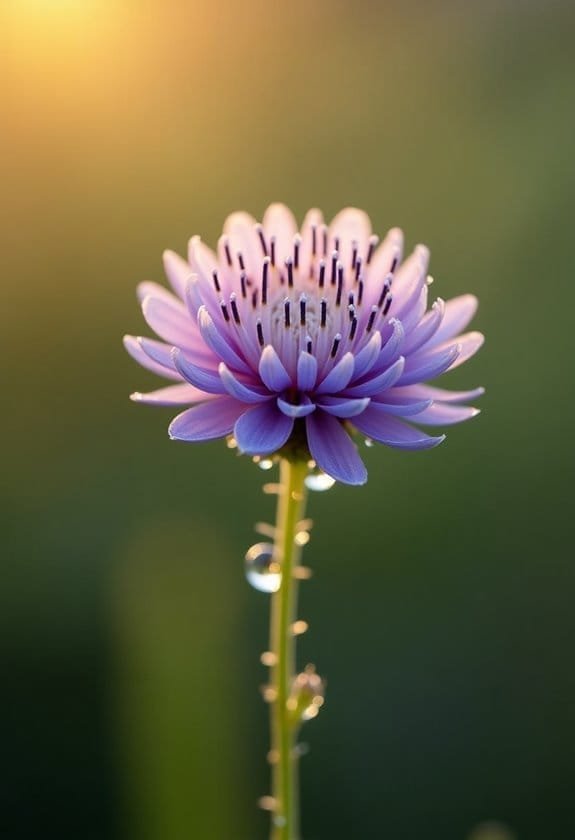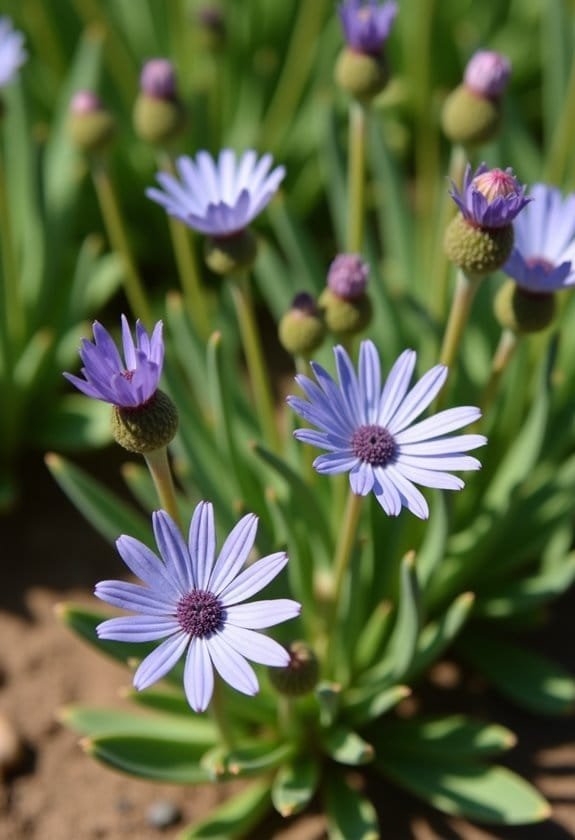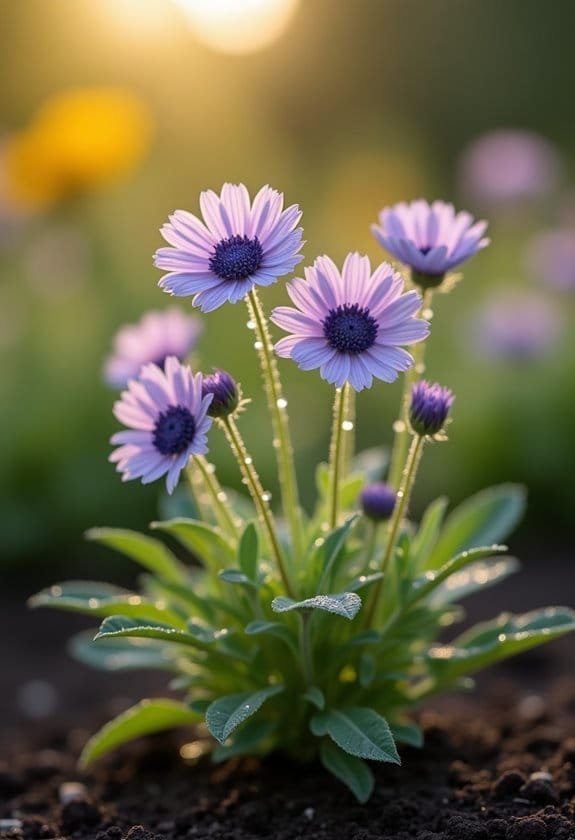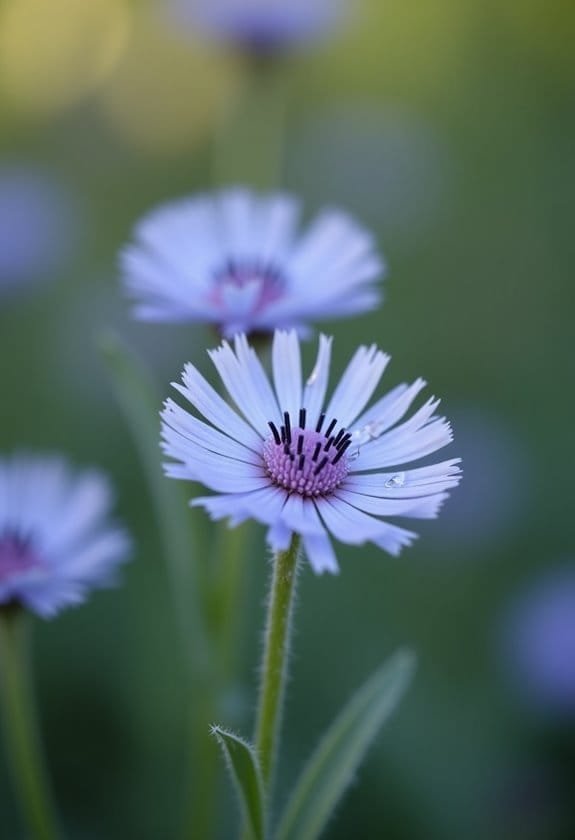Scabiosa spp., known as pincushion flowers or scabious, comprises about 30 species of flowering plants in the Caprifoliaceae family. These charming perennials and annuals showcase distinctive five-lobed blooms measuring 5-8 cm across, supported by basal rosettes of varied foliage. They thrive in full sun with well-draining soil and maintain continuous blooming from late spring through autumn, producing 20-50 fragrant flowers per plant. Native to Eurasia and the Mediterranean basin, Scabiosa serves as a crucial pollinator magnet, attracting bees and butterflies with its cupped blooms and extended flowering period. Their rich history and ecological significance offer compelling reasons to explore these garden treasures further.
Main Points
- Scabiosa are ornamental plants featuring unique five-lobed blooms in the Caprifoliaceae family, commonly known as pincushion flowers or scabious.
- Plants thrive in full sunlight and well-draining soil, producing fragrant flowers from late spring through autumn with 20-50 blooms per plant.
- Flowers attract pollinators like bees and butterflies, making them valuable garden additions for supporting local ecosystem biodiversity.
- Regular deadheading, consistent moisture, and balanced fertilization every two months promote healthy growth and continuous blooming.
- Plants range from compact annuals to tall perennials, with flower heads measuring 5-8 cm and varying foliage from smooth to intricately lobed.
Introduction

Scabiosa species, commonly known as pincushion flowers or scabious, represent a diverse genus of approximately 30 flowering plants within the family Caprifoliaceae.
These ornamental herbs, characterized by their distinctive five-lobed blooms arranged in rounded flower heads, have established themselves as valuable garden plants across temperate regions worldwide.
Native to Eurasia and the Mediterranean basin, Scabiosa's scientific name derives from Latin roots reflecting its historical medicinal applications, while its modern significance lies primarily in its ornamental value and role in supporting pollinator populations.
Common Name
The distinctive pincushion flower, commonly known as scabious, derives its name from the Latin word "scabiosus," meaning mangy or rough. This etymology reflects the plant's historical significance in folk medicine, where it was traditionally used to treat various skin conditions, particularly scabies. The name has persisted through centuries, though the plant's medicinal applications have largely given way to its ornamental value.
Among gardening enthusiasts, scabious has earned the endearing nickname "pincushion flower," which perfectly captures the unique structure of its blooming heads. The flower's distinctive appearance features numerous small florets nestled within protective bracts, creating a formation that remarkably resembles a traditional seamstress's pincushion.
This visual characteristic becomes even more pronounced as the blooms evolve into seed heads, maintaining their cushion-like shape while developing spiky protrusions. The species Scabiosa atropurpurea carries yet another common name, "sweet scabious," acknowledging its pleasantly fragrant blooms that come in a spectrum of colors.
These aromatic qualities, combined with the plant's ability to attract pollinators, have secured its place in both ornamental gardens and naturalized wildflower settings.
Scientific Name
Formally recognized in Linnaeus's "Species Plantarum" of 1753, the genus Scabiosa comprises roughly 30 distinct species of annual and perennial herbs. The scientific name Scabiosa derives from the Latin word "scabiosus," which aptly describes the plant's historical connection to treating skin conditions, particularly those characterized by roughness or scaling.
Within this taxonomically diverse genus, several species have gained prominence in both horticultural and botanical circles. Notable examples include Scabiosa atropurpurea, commonly known as Sweet Scabious, the compact Scabiosa columbaria (Dwarf Pincushion Flower), and the robust Scabiosa caucasica (Perennial Scabious). Each species maintains its unique characteristics while sharing the genus's fundamental traits.
The genus's natural distribution spans across temperate Eurasia and the Mediterranean region, where various species have evolved to flourish in different soil compositions and climatic conditions. This adaptive capability has contributed to the genus's successful establishment across diverse ecological niches, making it a fascinating subject for botanical studies and an invaluable addition to ornamental horticulture.
Overview
Within gardens worldwide, pincushion-like blooms of Scabiosa species stand as proof of their enduring ornamental appeal. These versatile plants, comprising approximately 30 distinct species, have established themselves as vital components of both formal gardens and naturalistic landscapes across temperate regions.
Scabiosa plants showcase their adaptability through both annual and perennial varieties, with each type offering unique characteristics that enhance garden aesthetics throughout the growing season. Their distinctive flower heads, resembling delicate cushions studded with pins, emerge above rosettes of basal leaves, creating an architectural presence in garden borders.
Native to Eurasia and the Mediterranean basin, these resilient plants have adapted to thrive in well-drained soils under full sun exposure, making them particularly suitable for xeriscaping and sustainable gardening practices.
Beyond their ornamental value, Scabiosa species play a significant role in supporting local ecosystems by attracting diverse pollinators, particularly bees and butterflies, which rely on their nectar-rich blooms.
The genus's historical significance extends to traditional medicine, where its Latin name reflects its past use in treating various skin conditions.
Key Features
Scabiosa species showcase remarkable diversity in their growth patterns, ranging from compact annuals of 30 centimeters to towering perennials reaching up to 1 meter in height.
Their distinctive appearance features basal rosettes of leaves supporting sturdy stems that culminate in rounded flower heads composed of numerous small, five-lobed blooms.
These resilient plants offer extended flowering periods from late spring through autumn, with peak blooming occurring during the warm summer months when their vibrant colors attract various pollinators.
Growth Size
The diverse family of pincushion flowers displays remarkable variation in growth size, ranging from compact cultivars to taller specimens. Annual varieties, particularly Scabiosa atropurpurea, demonstrate impressive vertical growth, reaching heights of up to 36 inches, while their perennial counterparts typically maintain more modest proportions.
Among the perennial varieties, Scabiosa columbaria, commonly known as the Dwarf Pincushion Flower, achieves a moderate height of approximately 24 inches, making it an excellent choice for intimate garden settings.
The Perennial Scabious (Scabiosa caucasica) stands slightly taller at 30 inches, compensating for its height with significantly larger flower heads. These blossoms can span anywhere from 3.5 to 8 centimeters in diameter, creating striking visual displays in garden beds.
Modern breeding efforts have produced specialized cultivars like the Flutter™ series, which maintain a compact growth habit of 12-14 inches while still delivering impressively sized blooms.
This variation in growth size allows gardeners to select specimens that perfectly suit their specific landscape requirements, whether they're designing borders, container gardens, or mixed perennial beds.
Appearance
Distinctive features of pincushion flowers captivate gardeners with their unique visual elements, from basal leaf rosettes to hairy or smooth leafy stems that support the plant's iconic blooms.
These scabious (Scabiosa) species showcase remarkable flower heads composed of numerous small, five-lobed blooms clustered together in a mesmerizing display.
The size variation among flowers adds to their diverse appeal, with Sweet Scabious producing delicate, fragrant blooms measuring 5 cm across, while Perennial Scabious commands attention with larger flowers spanning up to 8 cm in diameter.
The plant's foliage exhibits considerable diversity, featuring leaves that range from smooth and narrow-margined to intricately lobed or toothed formations.
Perhaps most striking is the persistent calyx that develops after flowering, transforming into a spiky crown that cradles single-seeded fruits like nature's own architectural masterpiece.
This structural element persists long after the blooms have faded, creating winter interest in gardens and providing an additional layer of visual intrigue to these already fascinating plants.
Flowering Season
Dazzling displays of colorful blooms grace gardens from early spring through the first frost, making Scabiosa species exceptional long-season performers. The flowering season reaches its zenith in May, when these charming plants produce an abundance of blooms in hues ranging from creamy yellow to deep burgundy, creating a tapestry of color in garden beds.
Each robust plant showcases between 20 to 50 fragrant flowers, transforming gardens into havens of continuous blooms throughout the growing season. When provided with ideal conditions, particularly 6-8 hours of daily sunlight, Scabiosa's flowering potential reaches its peak, guaranteeing a steady supply of blossoms for both garden enjoyment and cut flower arrangements.
Through consistent deadheading, gardeners can encourage a second flush of blooms in early fall, extending the display well into the cooler months. This impressive flowering duration, coupled with the plant's ability to produce viable scabiosa seeds, makes it an invaluable addition to perennial borders and cutting gardens.
The combination of prolonged blooming periods and diverse color options guarantees that Scabiosa maintains its visual impact throughout its extended flowering season.
Growing Requirements

Scabiosa thrives in full sunlight conditions, requiring 6-8 hours of direct exposure daily for ideal flowering and growth patterns.
These adaptable perennials demand well-draining, loamy soil enriched with organic matter, coupled with consistent moisture delivery of about one inch per week during their establishment phase.
While they demonstrate remarkable resilience in temperate climates within zones 5-9, their performance peaks when temperatures remain moderate, and they're protected from both excessive humidity and waterlogged conditions that might compromise their root systems.
Light
Growing healthy scabiosa plants relies heavily on providing proper light conditions. As natural light feeders, these ornamental plants demand full sun exposure, typically requiring 6-8 hours of direct sunlight daily to achieve their ideal growth potential and produce abundant blooms.
While scabiosa's sun requirements remain consistent across varieties, environmental factors can influence the suitable light arrangement. In regions with intense summer heat, providing partial afternoon shade can protect these delicate bloomers from excessive stress, ensuring sustained health throughout the growing season.
The relationship between light exposure and plant health becomes evident in the plant's response to inadequate illumination, as insufficient sunlight often manifests in stunted growth patterns and diminished flower production.
Careful monitoring of light conditions proves essential for maintaining vigorous scabiosa specimens, as these plants flourish best in moderate temperatures coupled with generous light exposure.
The symbiotic connection between adequate sunlight and plant health extends beyond mere survival, directly influencing the plant's ability to develop robust stems, lush foliage, and the characteristically full, rounded blooms that make scabiosa a prized garden specimen.
Soil
For ideal growth and flowering, successful cultivation of scabiosa relies on well-draining, loamy soil enriched with organic matter.
These elegant bloomers demonstrate a particular affinity for soil conditions that strike a delicate balance between moisture retention and efficient drainage, guaranteeing their root systems remain healthy and vibrant.
The best soil pH for scabiosa falls between 6.0 and 7.0, creating an environment where crucial nutrients become readily available to the plants.
Gardeners should be particularly vigilant about preventing waterlogged conditions, as excessive moisture can quickly lead to root rot and compromise the plant's overall health.
To enhance growing conditions, incorporating a layer of organic mulch helps maintain consistent soil moisture while regulating temperature fluctuations around the root zone.
Regular soil maintenance through the addition of compost proves instrumental in sustaining scabiosa's long-term health.
This practice not only improves the soil structure but also guarantees a steady supply of nutrients, creating an environment where these charming perennials can flourish throughout their growing season.
The investment in proper soil preparation ultimately rewards gardeners with robust plants and abundant blooms.
Water
Throughout their establishment period, these delicate blooms demand consistent moisture, requiring at least an inch of water weekly to develop robust root systems. This initial watering regimen is vital for promoting deep root development, which will serve the plant well in future growing seasons.
Once established, Scabiosa demonstrates remarkable drought tolerance, though they still benefit from supplemental watering during extended dry spells. Proper irrigation techniques focus on delivering water directly to the plant's base, keeping foliage dry to prevent fungal issues that can compromise plant health. This targeted approach maintains ideal moisture levels while protecting the plant's sensitive aerial parts.
Implementing a layer of mulch around Scabiosa creates an effective moisture-retention barrier, helping regulate soil temperature and reduce water loss through evaporation.
While these plants appreciate consistent moisture, they're particularly sensitive to waterlogged conditions, which can lead to devastating root rot. Gardeners should strike a careful balance, ensuring adequate drainage while maintaining sufficient moisture levels for healthy growth and abundant blooming throughout the season.
Temperature
Scabiosa's delicate nature demands specific temperature conditions for ideal growth and flowering. These perennial plants thrive best in moderate climates, displaying optimal performance when temperatures remain in the intermediate range, away from extremes that could stress their delicate systems.
In warmer regions, Scabiosa benefits from strategic placement in gardens where they can receive morning sun while enjoying protective shade during the intense afternoon heat. The relationship between temperature and moisture becomes particularly essential during establishment, as young plants require consistent soil moisture to develop robust root systems that will support their future drought tolerance.
Temperature management extends beyond air conditions to the soil environment, where well-draining, organically rich media helps maintain stable root zone temperatures. During periods of extreme heat, these adaptable plants may require additional care, including supplemental watering and temporary shade structures to maintain their vigorous growth pattern.
While Scabiosa demonstrates remarkable resilience once established, their preference for cooler conditions suggests careful consideration of planting locations in regions prone to prolonged heat waves or high humidity.
Pollinator Criteria
Scabiosa flowers serve as a crucial nectar source for numerous pollinators, particularly bees and butterflies, who are drawn to their abundant, easily accessible blooms.
Their extended flowering period, which continues from spring until the first frost, guarantees a consistent food supply for these essential garden visitors throughout the growing season.
The flowers' distinctive five-lobed structure and rich array of colors, from soft lavender to deep burgundy, make them particularly effective at attracting and sustaining diverse pollinator populations, contributing markedly to local ecosystem health.
Attracted Pollinators
As a magnet for garden pollinators, these richly nectared blooms attract an impressive array of beneficial insects. The distinctive pincushion flowers of Scabiosa species serve as natural feeding stations, offering abundant nectar that draws countless visitors throughout the growing season.
The unique architecture of Scabiosa blooms plays an essential role in their pollinator appeal, featuring a cupped shape that provides convenient landing platforms for various insects. Bees frequently visit these flowers, methodically working their way across the blooms while gathering both pollen and nectar.
Butterflies, particularly those attracted to Scabiosa columbaria, hover gracefully above the flowers, extending their proboscises to access the sweet rewards within.
The extended flowering period, which continues from spring until the first frost, makes Scabiosa an invaluable resource for maintaining healthy pollinator populations. Hoverflies join the diverse array of visitors, contributing to the plant's role in supporting local ecosystem biodiversity.
This sustained availability of nectar throughout the growing season helps guarantee the survival and prosperity of various pollinator species within garden environments.
Pollination Method
Through their specialized floral structure, these pincushion flowers employ both self-pollination and cross-pollination strategies to guarantee successful reproduction. The five-lobed bisexual blooms contain both male and female reproductive organs, enabling self-pollination when necessary, while their abundant nectar production encourages visits from diverse pollinators.
The plant's continuous blooming period, which extends from spring through the first frost, maximizes opportunities for successful pollination throughout the growing season. As pollinators move between different Scabiosa plants in search of nectar, they facilitate cross-pollination, enhancing genetic diversity within the species.
The flowers' distinctive structure, featuring small, closely packed florets, creates an efficient landing platform for visiting insects.
After pollination occurs, the calyx develops into a spiky crown-like structure, which serves a dual purpose: protecting the developing seeds and providing microhabitats for beneficial insects.
This evolutionary adaptation not only secures the plant's reproductive success but also contributes to the broader ecosystem's health by supporting local pollinator populations.
Care & Maintenance

Successful cultivation of Scabiosa species starts with proper planting in well-draining soil and consistent moisture management during the establishment period.
Gardeners should implement a regular maintenance schedule that includes deadheading spent blooms, monitoring for aphids, and providing balanced fertilization every two months throughout the growing season.
These hardy perennials thrive alongside drought-tolerant companions like Salvia and Echinacea, creating a harmonious garden display while sharing similar care requirements and attracting beneficial pollinators.
Planting Tips
Growing healthy Scabiosa plants requires attention to proper timing and soil conditions. These versatile cut flower favorites thrive when planted in early spring after frost danger has passed, or during late fall in regions with mild winters. For ideal development, gardeners should space plants at least 12 inches apart, allowing sufficient room for their mature spread.
Success with Scabiosa cultivation hinges on providing the right growing environment, particularly regarding soil composition and drainage. These plants flourish in loamy, well-draining soil enriched with organic matter, which prevents the detrimental effects of waterlogging and subsequent root rot.
During their establishment period, consistent moisture is essential, with young plants requiring approximately one inch of water weekly, adjusting the amount during periods of intense heat. While mature specimens display admirable drought tolerance, maintaining steady moisture levels promotes robust growth and abundant blooming.
To maximize flowering potential and guarantee vigorous growth, apply a balanced fertilizer every two months throughout the growing season. This systematic approach to planting and initial care establishes a strong foundation for healthy, flowering Scabiosa specimens.
Ongoing Care
Scabiosa's long-term success relies on consistent maintenance throughout the growing season. The ongoing care regimen includes regular deadheading of spent blooms, which stimulates continuous flower production from spring until the first frost arrives.
Water young scabiosa plants meticulously, ensuring they receive no less than one inch of moisture per week to establish strong root systems. Once mature, these resilient plants demonstrate impressive drought tolerance, though they'll still benefit from occasional deep watering during extended dry spells.
To maintain vigorous growth and abundant flowering, apply a balanced fertilizer every other month during active growth periods.
Vigilant pest management is essential, as aphids and spider mites can compromise plant health. When infestations occur, treat affected plants promptly with mild insecticides or neem oil solutions to prevent widespread damage.
Every few years, implement a strategic pruning routine to manage plant size and promote robust growth. This rejuvenating process, performed every two to three years, helps maintain the plant's architectural form while encouraging fresh vegetative growth and maximizing bloom production throughout subsequent seasons.
Suggested Companions
Three key companion groups make Scabiosa a versatile garden addition: drought-tolerant perennials, aromatic herbs, and pollinator-friendly flowers. When planning companion planting for Pincushion Flower, gardeners should consider drought-resistant partners like lavender and salvia, which share similar cultural requirements and create a harmonious water-wise display.
Aromatic herbs play an essential role in supporting Scabiosa's health and vigor. Thyme and oregano act as natural pest deterrents, while their low-growing habits complement the upright nature of Scabiosa stems.
Taller perennials, such as delphiniums and hollyhocks, provide an elegant backdrop that enhances the overall garden composition and offers structural support.
Ground-level companions deserve careful consideration in the planting scheme. Creeping thyme and ajuga form living mulch beneath Scabiosa, suppressing weed growth and maintaining soil moisture.
To create a vibrant ecosystem, incorporating pollinator-friendly plants like echinacea and rudbeckia alongside Scabiosa establishes a diverse habitat that attracts beneficial insects, ensuring robust pollination throughout the growing season.
Common Issues
Scabiosa plants face several common challenges, including persistent pests like aphids, spider mites, and thrips, which can be effectively managed using mild insecticides or neem oil applications.
The plants' sensitivity to moisture makes them particularly vulnerable to fungal diseases such as leaf spot and root rot, especially when grown in poorly draining soil conditions.
Regular monitoring for pest infestations and disease symptoms, combined with proper cultural practices like ensuring adequate air circulation and avoiding overwatering, helps maintain healthy, vigorous plants throughout the growing season.
Pests/Diseases
Throughout the growing season, gardeners should watch out for several common pests and diseases that can affect Scabiosa plants. The most frequent pests include persistent aphids, which cluster on stems and leaves, as well as spider mites, slugs, and thrips that can considerably damage both foliage and blooms.
These unwanted visitors often leave visible signs of their presence, from distorted growth to spotted leaves.
Disease management presents another essential challenge, with powdery mildew emerging as a primary concern in humid conditions. This fungal infection manifests as a white, powdery coating on leaves, while root rot can silently destroy the plant from below in poorly drained soils.
To combat these issues, gardeners should implement an integrated approach to plant health. This includes applying mild insecticides or neem oil for pest control, maintaining proper spacing between plants for adequate air circulation, and ensuring soil drainage is ideal.
Watering techniques play a significant role, too – directing water at the plant's base rather than overhead helps prevent leaf spot and other moisture-related diseases that could compromise the plant's vitality.
Solutions
While maintaining healthy Scabiosa plants may seem challenging, most common issues have straightforward solutions.
Gardeners can effectively manage common pests like aphids and spider mites through the application of mild insecticides or natural alternatives such as neem oil, which provides excellent control without harsh chemicals.
Proper watering practices are vital in preventing moisture-related diseases, particularly root rot and powdery mildew.
Installing well-draining soil and implementing a consistent watering schedule that allows the soil to dry slightly between applications can greatly reduce these issues.
For plants struggling with insufficient blooming, repositioning them to receive 6-8 hours of direct sunlight daily often resolves the problem.
Regular maintenance practices, such as deadheading spent blooms and implementing a measured fertilization program, can dramatically improve plant health and flowering performance.
When applying fertilizer, it's important to maintain a conservative approach, feeding plants with a balanced formula every two months rather than overwhelming them with excessive nutrients, which can inhibit bloom production.
Summary

From within the Mediterranean region and temperate Eurasia, this diverse genus of flowering plants comprises roughly 30 species of annual and perennial herbs. Scabiosa species are distinguished by their distinctive basal leaf rosettes and intriguing flower heads, which feature delicate, five-lobed blooms that create an enchanting display in gardens and natural settings.
Notable members of this genus include the aromatic Sweet Scabious (Scabiosa atropurpurea) and the compact Dwarf Pincushion Flower (Scabiosa columbaria), which reaches heights of 60 centimeters with its characteristic light blue flowers.
These adaptable plants thrive in well-drained soils under full sun conditions, requiring thoughtful watering practices to maintain ideal growth. Modern gardeners particularly value cultivars such as the deep burgundy-flowered Black Knight and the enduring Pink Mist, which offers nearly year-round blooming in mild climates.
Beyond their ornamental appeal, Scabiosa species play an essential role in supporting garden ecosystems by attracting crucial pollinators, including bees and butterflies, making them both aesthetically pleasing and ecologically significant additions to any landscape.


